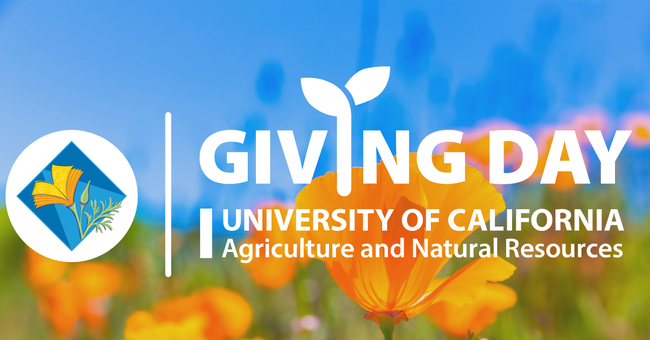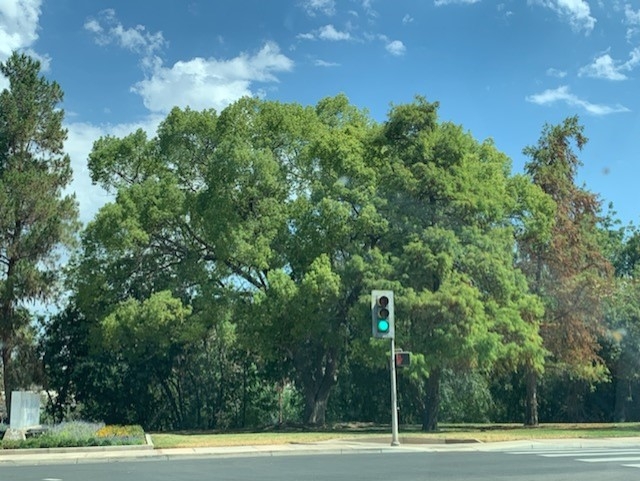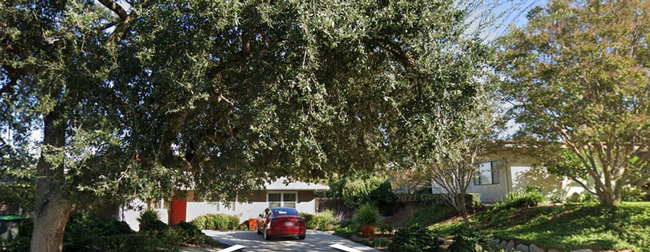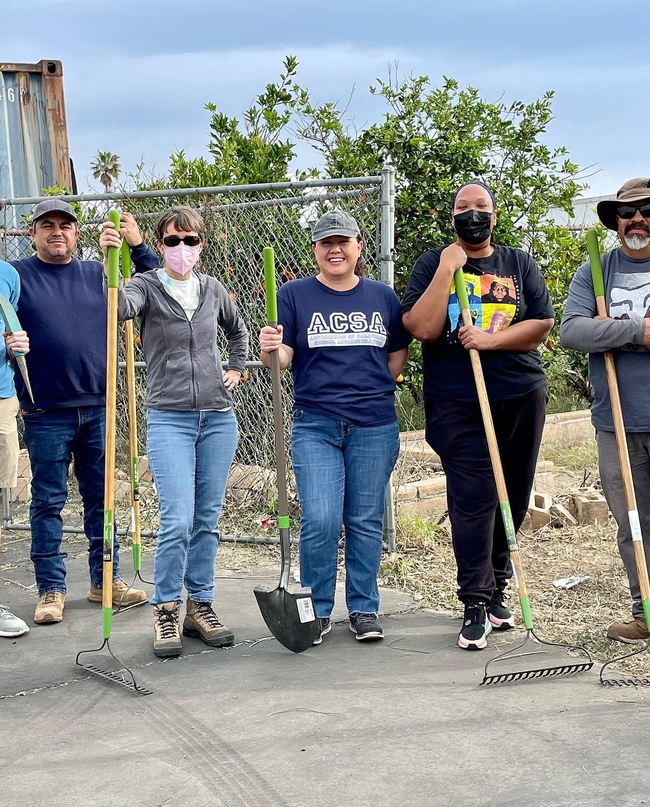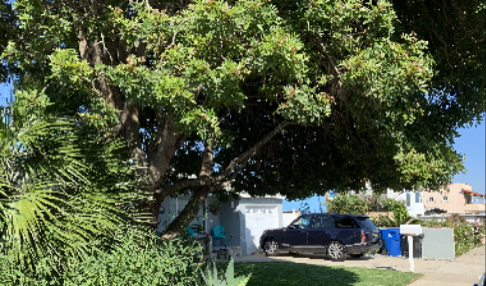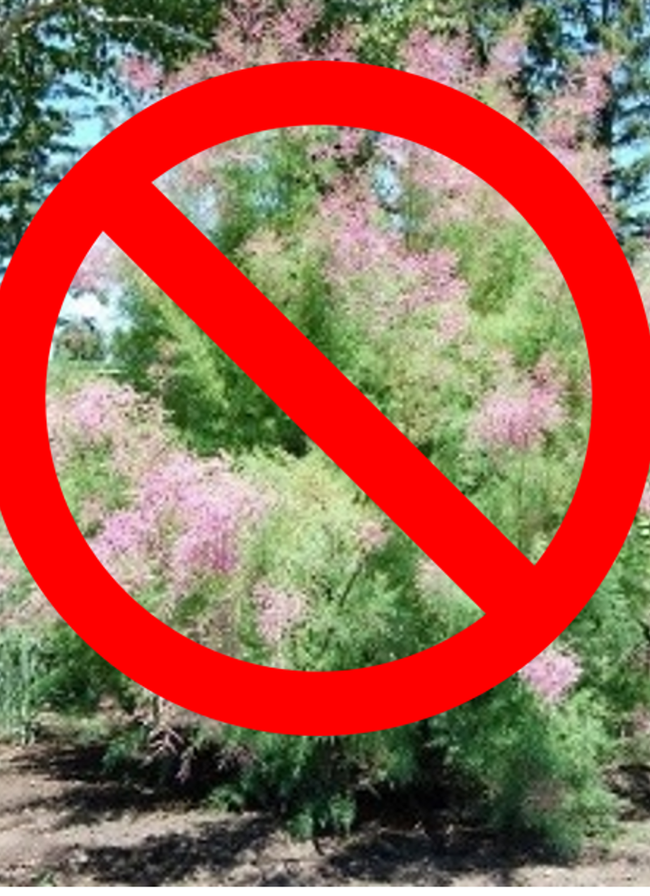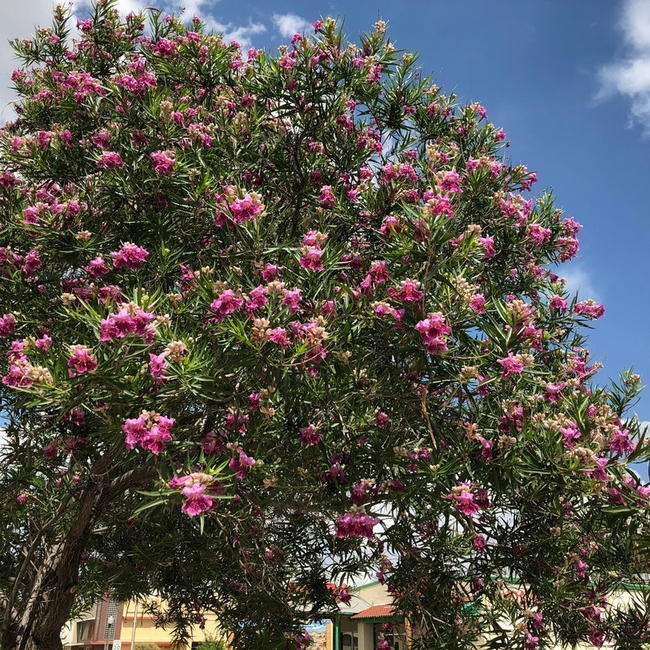Posts Tagged: uc anr
Dig Deep and Support Sustainable Gardening on UC ANR Giving Day!
It's time to come together and support the UC Master Gardener Program's mission, mark your calendars! On May 18-19, from noon to noon the UC Master Gardener Program is launching its statewide giving day, UC ANR Giving Day. This special event invites you to join hands and contribute to our mission of extending sustainable gardening practices to thousands of community, school, and demonstration gardens across California. By donating to the UC Master Gardener Program, you can help bring the knowledge and resources of the University to your local community.
Get ready to dig deep, spread the word, and make a difference!
As gardeners, we understand the importance of sustainable practices in nurturing green spaces and preserving the natural environment. The UC Master Gardener Program has been at the forefront of promoting sustainable gardening for decades, empowering individuals and communities to cultivate vibrant and resilient gardens. By supporting the UC Master Gardener Program, you contribute to the advancement of sustainable gardening practices throughout the state, fostering healthier gardens and communities.
UC ANR Giving Day offers various ways for you to show your support and get involved. Whether you are an avid gardener, a passionate environmentalist, or simply someone who recognizes the value of sustainable practices, there's a place for you in this collective effort.
- Make a Gift:
Visit donate.ucanr.edu/givingday during the 24-hour giving day on May 18-19 (noon to noon). Every donation, regardless of size, makes a significant impact on the UC Master Gardener Program's ability to continue its valuable work. Whether you contribute $5 or $500, your support helps fund educational resources, outreach programs, and training opportunities for dedicated UC Master Gardener volunteers who drive sustainable gardening efforts across the state. - Help Spread the Word:
Mark your calendar and spread the word about UC ANR Giving Day! Share the event details with your friends, family, and fellow gardening enthusiasts. Encourage them to join you in supporting this important cause. Together, we can create a ripple effect of positive change by raising awareness and inspiring others to get involved. - Engage on Social Media:
On May 18-19, be part of the excitement by joining in the conversation on social media. Use the hashtag #GivingDay to share your support for UC ANR Giving Day. Let your online community know why sustainable gardening is important to you. Together, we can amplify our message and inspire others to take action.
UC ANR Giving Day is an opportunity to unleash the power of giving and support sustainable gardening practices across California. By supporting the UC Master Gardener Program and UC ANR, you contribute to the extension of knowledge and resources to communities across California. Remember to mark your calendar for May 18-19, and join in the celebration of sustainable gardening. Let's dig deep, donate, spread the word, and make a lasting impact together!
To make your contribution and learn more about UC ANR Giving Day, visit donate.ucanr.edu/givingday.
Climate change resources for Horticulturists, Government Officials, and UCCE Master Gardeners
Climate Change Resources for Horticulturists and UCCE Master Gardeners
Updated by Janet Hartin jshartin@ucanr.edu 8/17/2022
University of California UC ANR Green Blog (Climate Change and Other Topics) https://ucanr.edu/blogs/Green/index.cfm?tagname=climate%20change (full index)
Examples:
- Save Trees First: Tips to Keep Them Alive Under Drought https://ucanr.edu/b/~CdD
- Landscaping with Fire Exposure in Mind: https://ucanr.edu/b/~G4D
- Cities in California Inland Areas Must Make Street Tree Changes to adapt to Future Climate https://ucanr.edu/b/~oF7
UC Climate Change Videos
Drought, Climate Change and California Water Management Ted Grantham, UC Cooperative Extension specialist (23 minutes) https://youtu.be/dlimj75Wn9Q
Climate Variability and Change: Trends and Impacts on CA Agriculture Tapan Pathak, UC Cooperative Extension specialist (24 minutes) https://youtu.be/bIHI0yqqQJc
California Institute for Water Resources (links to blogs, talks, podcasts, water experts, etc.) https://ciwr.ucanr.edu/California_Drought_Expertise/
UC ANR Wildfire Resources (publications, videos, etc.) https://ucanr.edu/News/For_the_media/Press_kits/Wildfire/ (main website)
UC ANR Fire Resources and Information https://ucanr.edu/sites/fire/ (main website)
Preparing Home Landscaping https://ucanr.edu/sites/fire/Prepare/Landscaping/
UC ANR Free Publications https://anrcatalog.ucanr.edu/ (main website)
Keeping Plants Alive Under Drought and Water Restrictions (English version) https://anrcatalog.ucanr.edu/pdf/8553.pdf
(Spanish version) https://anrcatalog.ucanr.edu/pdf/8628.pdf
Use of Graywater in Urban Landscapes https://anrcatalog.ucanr.edu/pdf/8536.pdf
Sustainable Landscaping in California https://anrcatalog.ucanr.edu/pdf/8504.pdf
Other UC (Non-ANR) scientists
Daniel Swain (UCLA): website: https://weatherwest.com/ twitter: @Weather_West
Non-UC Climate Change Resources
Urban Forests and Climate Change. Urban forests play an important role in climate change mitigation and adaptation. Active stewardship of a community's forestry assets can strengthen local resilience to climate change while creating more sustainable and desirable places to live. https://www.fs.usda.gov/ccrc/topics/urban-forests
Examining the Viability of Planting Trees to Mitigate Climate Change (plausible at the forest level) https://climate.nasa.gov/news/2927/examining-the-viability-of-planting-trees-to-help-mitigate-climate-change/
Reports and other information resources coordinated under the auspices of the United Nations and produced through the collaboration of thousands of international scientists to provide a clear and up to date view of the current state of scientific knowledge relevant to climate change. United Nations Climate Action
Scientific reports, programs, action movements and events related to climate change. National Center for Atmospheric Research (National Science Foundation)
Find useful reports, program information and other documents resulting from federally funded research and development into the behavior of the atmosphere and related physical, biological and social systems. Search and find climate data from prehistory through to an hour ago in the world's largest climate data archive. (Formerly the "Climatic Data Center") National Centers for Environmental Information (NOAA)
Think tank providing information, analysis, policy and solution development for addressing climate change and energy issues (formerly known as the: "Pew Center on Global Climate Change"). Center for Climate & Energy Solutions (C2ES)
Mapping Resilience: A Blueprint for Thriving in the Face of Climate Disaster. The Climate Adaptation Knowledge Exchange (CAKE) was launched in July 2010 and is managed by EcoAdapt, a non-profit with a singular mission: to create a robust future in the face of climate change by bringing together diverse players to reshape planning and management in response to rapid climate change. https://www.cakex.org/documents/mapping-resilience-blueprint-thriving-face-climate-disaster
Cal-Adapt provides a way to explore peer-reviewed data that portrays how climate change might affect California at the state and local level. We make this data available through downloads, visualizations, and the Cal-Adapt API for your research, outreach, and adaptation planning needs. Cal-Adapt is a collaboration between state agency funding programs, university and private sector researchers https://cal-adapt.org/
Find reports, maps, data and other resources produced through a confederation of the research arms of 13 Federal departments and agencies that carry out research and develop and maintain capabilities that support the Nation's response to global change. Global Change (U.S. Global Change Research Program)
The Pacific Institute is a global water think tank that combines science-based thought leadership with active outreach to influence local, national, and international efforts to develop sustainable water policies. https://pacinst.org/our-approach/
Making equity real in climate adaptation and community resilience policies and programs: a guidebook. https://greenlining.org/publications/2019/making-equity-real-in-climate-adaption-and-community-resilience-policies-and-programs-a-guidebook/
Quarterly CA Climate Updates and CA Drought Monitor Maps (updated each Thursday) https://www.drought.gov/documents/quarterly-climate-impacts-and-outlook-western-region-june-2022
Drought Resources for Keeping Trees Alive
University of California Cooperative Extension Drought Resources To Keep Your Plants Alive
"Trees Come First Under Drought and Water Restrictions"
Keeping Plants Alive Under Drought and Water Restrictions (English) https://anrcatalog.ucanr.edu/pdf/8553.pdf
Keeping Plants Alive Under Drought and Water Restrictions (Spanish) https://anrcatalog.ucanr.edu/pdf/8628.pdf
Prioritizing Trees During Drought and Water Restrictions (5 minute Youtube)
https://www.youtube.com/watch?v=CTKLlJgdLVk
Tips to Keep Your Landscape Trees Alive Under Drought https://ucanr.edu/b/~IjC
Landscape Tree Irrigation to Maximize Tree Health, Benefits, and Beauty https://ucanr.edu/b/~YjA
Landscape Tree Irrigation 101 https://ucanr.edu/b/~UjA
Top 10 Ways to Conserve Water in Your Landscape and Garden https://ucanr.edu/b/~tTD
Asphalt and Synthetic Turf are Superheating our Cities (in Desert Sun newspaper) https://www.desertsun.com/story/opinion/contributors/valley-voice/2022/04/09/coachella-valleys-asphalt-synthetic-lawn-heat-islands-reach-170/9515857002/
Use of Graywater in Urban Landscapes in California https://anrcatalog.ucanr.edu/pdf/8536.pdf
Need More Help? Speak to a UC Cooperative Extension Master Gardener in Your County of Residence.
Find email and phone helplines here: Find a UC Master Gardener Program - UC Master Gardener Program (ucanr.edu)The Top Ten Ways to Conserve Water in Your Landscape and Garden in San Bernardino County
1. Select drought-resistant plants that grow well in your climate zone and microclimate (sun, shade, etc.). Try these search engines:
SelecTree: A Tree Selection Guide (calpoly.edu) Plant Search Database
Plant Search Database - Water Use Classification of Landscape Species (WUCOLS IV) (ucanr.edu)
For inland San Bernardino County: Home - Inland Valley Garden Planner
2. ‘Hydrozone': Place plants with similar water needs (very low, low, medium, high) together and water the hydrozones on different valves (or, if hand watering, water plants requiring the most water longer but not necessarily more often than other plants).
3. Make sure your irrigation system is operating properly (pressure, spacing, no weeds around heads, no broken parts, etc.).
4. Irrigate based on species and seasonal water needs (highest in summer) and soil type (sandy loam, clay loam, etc.).
5. Irrigate slightly below the current root zone depth of your plants to encourage deep rooting into cooler soil: - 6”-8” for annuals, perennials, and turf - 8”- 1' for shrubs - 1' or deeper for trees
6. Water early in the morning when soil evaporation is minimal.
7. Control weeds. They compete with your garden plants for water.
8. Spread and maintain 2-4” of mulch around garden plants and trees (3-4” for wood chips, 2” for pebbles, decomposed gravel, etc.) keeping it a few inches away from tree trunks.
9. Avoid over-fertilizing. Too much nitrogen creates weak growth and the need for more water.
10. If you have a lawn and still want to keep it, water based on the UC ANR 'Lawn Watering Guide': http://ucanr.org/freepubs/docs/8044.pdf
Contact a trained University of California Cooperative Extension (UCCE) Master Gardener in San Bernardino County for more help! mgsanbern@ucanr.edu (fastest!) or: (909)387-2182 (leave a message for a return phone call)
Redlands trees
Invasive Trees to Avoid/Suggested Alternatives
Many previously “welcomed” urban tree species have outlived their stay, becoming invasive and crowding out other plants in our Southern California landscapes. You can help by avoiding planting these trees identified by various sources (including the California Invasive Plant Council) to be too aggressive and habitat/resource-depleting for further planting.
Invasive Trees to Avoid Planting
Athel (Tamarix aphylla)
Black Locust (Robinia pseudoacacia)
Blackwood Acacia (Acacia melanoxylon)
Brazilian Pepper (Schinus terebinthifolius)
Chinaberry (Melia azedarach)
Chinese Tallow Tree (Triadica sebifera)
English Hawthorn (Crataegus monogyna)
Peruvian Pepper Tree (Schinus molle)
Red Gum (Eucalyptus camaldulensis)
Russian Olive (Elaeagnus angustifolia)
Saltcedar (Tamarix ramosissima, T. gallica, T. chinensis)
Silver Wattle (Acacia dealbata)
Smallflower Tamarisk (Tamarix parviflora)
Tasmanian Bluegum (Eucalyptus globulus)
Plant These Instead
They are drought/heat resistant, low maintenance, and have no known significant pest or disease problems and are not currently overplanted). Find other suggestions here: https://www.cal-ipc.org/solutions/prevention/landscaping/dpp/?region=socal
African Fern Pine (Afrocarpus falcatus) (formerly Podocarpus elatior)
Cascolote (Caesalpinia cacalaco Smoothie®)
Desert Willow ‘Bubba' (Chilopsis linearis)
Fringe Tree (Chionanthus virginicus)
Island Oak (Quercus tomentella)
‘Maverick' Mesquite (Prosopis glandulosa)
Mulga (Acacia aneura)
Netleaf Hackberry (Celtis reticulata)
Pink Chitalpa (x Chitalpa tashkentensis 'Pink Dawn')
‘Red Push' Pistache (Pistacia x ‘Red Push')
Thornless South American Mesquite (Prosopis x Phoenix)





